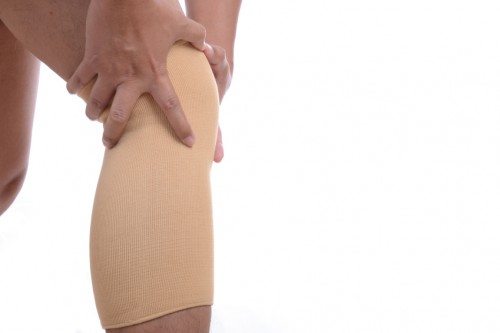
Fighting a bum knee, nursing an overworked elbow, or maybe just worrying about a family history of joint issues? Whatever the state of your joints, you don’t have to give up on staying in shape! There are countless ways to support your joints while you exercise, minimizing the impact, potential for slips and twists, and other causes of damage as you get in your daily exercise. The next time you hesitate to work out because of your joints, consider one of these joint support solutions:
Straps
Wearing small straps just above or below the joint don’t offer much in the way of support for the bone or muscle around your joints, but they can work wonders for keeping you from a nasty case of tendonitis. If you’re prone to tennis elbow and other forms of the condition, a small strap might be plenty to keep you fine. For anything more, you’ll want a bit more in the way of support.
Compression sleeve
 A nice compromise between support and flexibility, putting a close-fitting compression sleeve over your joint offer you several benefits. Fitted properly, a compression sleeve will help prevent hyperextension, hold everything in place to protect you against sprains and other misalignments, and improve the flow of blood around the joint. Beware of improper fits rubbing you raw and offering no benefit, but be sure you have a good range of motion for your activities of choice.
A nice compromise between support and flexibility, putting a close-fitting compression sleeve over your joint offer you several benefits. Fitted properly, a compression sleeve will help prevent hyperextension, hold everything in place to protect you against sprains and other misalignments, and improve the flow of blood around the joint. Beware of improper fits rubbing you raw and offering no benefit, but be sure you have a good range of motion for your activities of choice.
Braces
In cases of severe joint problems, a full fixed brace might be warranted as protection against injury—but you’ll be sacrificing a lot of mobility for that protection. Utilize braces when the risk to your joint outweighs the benefits of the mobility by a wide margin. If you need this degree of support but want to a better range of motion, consider a hinged variation—these can be tricky to get right, but offer full support and mobility.
Bandage wrap
Sometimes, the classic solutions to problems work the best. Few support solutions offer the versatility, mobility, and support of a proper elastic bandage wrap—but pay close attention to the work ‘proper’. You’ll want to do your research on how to properly wrap the joint you’re protecting, you’ll want to be careful to secure it properly, and you’ll want to refix it if or when it starts to loosen or slip. There’s an amount of upkeep and skill involved in using bandage wraps that other solutions don’t have, but you gain a lot for the effort—so don’t write these off as a dated solution.
Of course, if you have a pre-existing joint condition, you’ll want to run any joint support solution past your doctor or physical therapist first—they’ll understand your needs and weigh them versus your wants better than you can manage looking at your options and guessing alone. So don’t hesitate to ask them their opinion!


